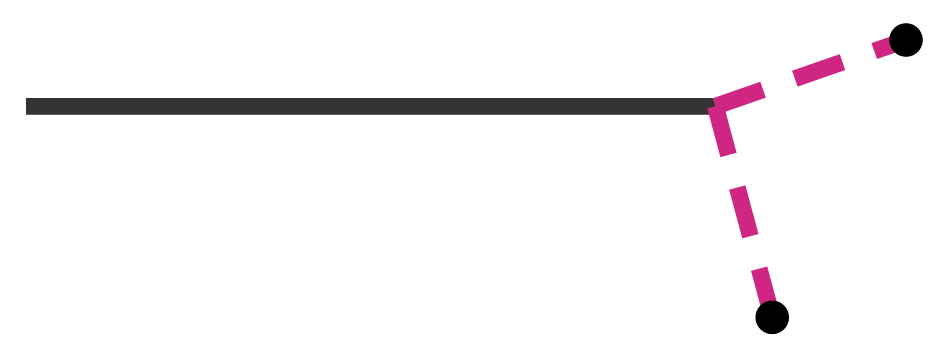fork-bone
v3.0.1
Published
Given three points, a, b, and c, and a length p, finds two points that are length p away from b that sit on the bisecting line of the angle between lines ab and bc.
Downloads
23
Readme
fork-bone
Given a "bone" line, creates two points. If a line is drawn from the end of the bone to each of the points, these two new lines will be branches that "fork" off of the bone. The points, while chosen randomly, create branches that are guaranteed to:
- Not be on the same side of the ray that would be created by extending the bone indefinitely.
- Form an acute angle with the bone ray.
- Be within the length range specified.
Installation
npm install fork-boneUsage
var ForkBone = require('fork-bone');
var forkBone = ForkBone();
console.log(forkBone({
line: [
[-50, 0],
[-9, 0]
],
lengthRange: [5, 15]
}));Output:
[
[ 2.3339615604739095, -3.9422474992952727 ],
[ -5.620344845177656, 12.553004860768706 ]
]A graph of the line with the resulting fork:

Pass symmetrical: true if you want the forks to be symmetrical.
Pass angleRange: [<lower bound in degrees>, <upper bound> if you want to have a particular angle away from ray extending from the end of the bone. For example, [30, 45] will result in forks that are between 60 and 90 degrees apart from each other.
Pass a two-element array in lengthRange if you want to define the fork length range. The first element should be the bottom of the range, and the second should be the top.
When creating ForkBone, you can optionally pass two opts:
random: A function that behaves likeMath.random. You can substitute one created by seedrandom or something you've written yourself. Helps with situations in which you want reproducible results.numberOfDecimalsToConsider: A positive number that tells it how precise to be when picking numbers in a range. If it encounters a range of 0.001, by default, it will always pick 0. (If the range is 100, it'll pick a whole number between 0 and 99.) If you specify 3 asnumberOfDecimalsToConsider, it can pick numbers like 0.003 and 0.995. Useful for working for points that are really close together.
Tests
Run tests with make test.
Run test in browser with make test-firefox.
Tests and tools require Node 6. Module itself should work in all versions of Node and modern browsers.
License
The MIT License (MIT)
Copyright (c) 2016 Jim Kang
Permission is hereby granted, free of charge, to any person obtaining a copy of this software and associated documentation files (the "Software"), to deal in the Software without restriction, including without limitation the rights to use, copy, modify, merge, publish, distribute, sublicense, and/or sell copies of the Software, and to permit persons to whom the Software is furnished to do so, subject to the following conditions:
The above copyright notice and this permission notice shall be included in all copies or substantial portions of the Software.
THE SOFTWARE IS PROVIDED "AS IS", WITHOUT WARRANTY OF ANY KIND, EXPRESS OR IMPLIED, INCLUDING BUT NOT LIMITED TO THE WARRANTIES OF MERCHANTABILITY, FITNESS FOR A PARTICULAR PURPOSE AND NONINFRINGEMENT. IN NO EVENT SHALL THE AUTHORS OR COPYRIGHT HOLDERS BE LIABLE FOR ANY CLAIM, DAMAGES OR OTHER LIABILITY, WHETHER IN AN ACTION OF CONTRACT, TORT OR OTHERWISE, ARISING FROM, OUT OF OR IN CONNECTION WITH THE SOFTWARE OR THE USE OR OTHER DEALINGS IN THE SOFTWARE.
